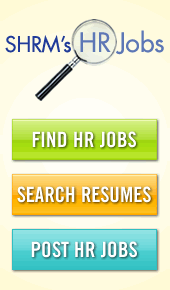Diversity
Inclusion 2021 Conference hosted by SHRM (Oct 25-27, 2021)
Join us at INCLUSION 2021 for three engaging days of learning and networking. You will get the tools, best practices and actionable solutions you need to build a more diverse, equitable and inclusive workplace; visit https://conferences.shrm.org/inclusion for more information.
Together Forward @Work
It's time for equality for all, across every area of society. That's why SHRM has introduced Together Forward @Work, a call to action to bring racial equity to the workplace - the place we know best and have served the longest. And a place where we, our members, and our business community can bring our unique professional talents to stand together against all forms of social injustice.
https://togetherforwardatwork.shrm.org/
Coming Soon: Getting Talent Back to Work Certificate
https://www.gettingtalentbacktowork.org/
Free, multi-faceted educational journey will launch in June 2020. Helping employers confidently hire individuals with a criminal background.
Read this SHRM article about New, Free HR Training Program Closes Disability Inclusion Gap in the Workplace (April 21, 2020)
Focus on Inclusion - Not just Diversity
In the most basic sense, according to SHRM resources, diversity is about counting people, while inclusion is about making people count.
Organizations are making people count by taking advantage of the mix of races, ethnicities, ages, gender identities, religions and life experiences in their workforce. Leaders are going out of their way to solicit employees’ opinions. Some are even insisting that workers contribute honestly during meetings—and guaranteeing that they won’t be punished for saying something that management might not want to hear.
Workplace Flexibility includes:
· Choices in Managing Time: includes control over one’s schedule and agreeing that the schedule or shift meets his or her needs.
· Flex Time and Flex Place: includes traditional flexibility, daily flexibility (short-notice schedule changes), compressed workweeks, and working at home.
· Reduced Time:includes full-timers who could arrange to work part time in their current position and part-timers who could arrange to work full time in their current position as well as part-year work.
· Time Off: includes a lack of difficulty in taking time for personal or family matters, paid days off for personal illness, paid days off to care for sick children, time off for elder care without fear of losing one’s job, paid vacation time, paid holidays, time off for volunteering without the loss of pay, and caregiving leaves for birth, adoption, and seriously ill family members.
· Flex Careers: enable employees to dial up or dial down their careers by taking extended time off for caregiving or sabbaticals. They also enable employees to phase into retirement.
· Dealing with Overwork: includes efforts to create reasonable work demands, to reduce unnecessary work and to create boundaries between life on and off the job.
· Culture of Flexibility: includes not having to choose between advancement and devoting attention to family life, not having advancement jeopardized by asking for flexibility, and overall supervisor support when work-life issues arise.
Organizations that provide more effective and flexible work environments have been shown to have more engaged, satisfied, and healthier employees with fewer intentions of looking for new employment. These effects can be seen in a variety of industries and across a range of employee groups. As workplaces become more intense, organizations find that they must become more flexible to support employees in effectively managing their demands at work and at home and to attract, develop, and retain the employees they need to succeed.
Diversity Presentation from GVHRA Meeting (January 2011) - available on "Members Only" page
Veterans at Work
https://www.shrm.org/foundation/about/Pages/Veterans-at-Work-Certificate-Program.aspx
The SHRM Foundation Veterans at Work Certificate, developed for HR professionals, hiring managers, and front-line supervisors, is a multi-faceted program from the SHRM Foundation and brought to you with generous support from Comcast NBCUniversal. Through this certificate program you will:
- Learn the value that skilled veterans bring to the civilian workplace
- Demonstrate your commitment to attract, hire and retain these talented professionals
- Earn 10 professional development credits toward your SHRM-CP or SHRM-SCP recertification
Additional Veteran's resources include the following:
SHRM webcast archive: Employing America's Veterans - What Professionals Need to Know about Veterans
Website: http://mymilitarytransition.com
Employer Support of the Guard and Reserve (ESGR) is a Department of Defense agency that seeks to develop and promote a culture in which all American employers support and value the military service of their employees. It does so by recognizing outstanding support, increasing awareness of the law, and resolving conflicts through mediation. ESGR informs and educates service members and their civilian employers regarding their rights and responsibilities under the Uniformed Services Employment and Reemployment Rights Act (USERRA). Established in 1972, ESGR operates via a network of hundreds of volunteers within 56 field committees throughout the United States. The website below provides resources for service members, employers, and volunteers.
Website: http://www.esgr.org/site/Home.aspx
Employing Abilities @Work
https://employingabilities.org/
This free, multi-faceted educational program will increase your knowledge and skills to hire, develop, advance and retain individuals with disabilities. This Certificate is an introduction to the benefits and implementation of disability inclusion in the workplace. Earn 10PDCS toward your SHCM-CP or SHRM-SCP recertification.
Held each October, National Disability Employment Awareness Month (NDEAM) is a national campaign that raises awareness about disability employment issues and celebrates the many and varied contributions of America's workers with disabilities. The theme for NDEAM 2011 is Profit by Investing in Workers with Disabilities, which promotes the valuable contributions people with disabilities make to America's workplaces and economy. 2011 NDEAM posters are now available to download or order. For more information visit https://www.disability.gov/employment/news_%26_events.
- Montana Court Says Obesity May Be Impairment, Protected Against Discrimination
From the Associated Press
Excerpt: "The state Supreme Court says obesity qualifies as an impairment in some cases under the Montana Human Rights Act, potentially allowing obese people to seek greater protection against discrimination."
- How to Avoid Legal Battles Over Dress Codes
By David Barron, Diversity Executive Magazine
Excerpt: "Conflicts over dress codes and requests for accommodation abound in an increasingly diverse workforce. Here are some legal tips diversity leaders should take into account.
What if a company’s new receptionist shows up for work wearing a headscarf? Or a male truck driver refuses to shave his beard because growing a beard is an essential part of his cultural identity?
Title VII of the Civil Rights Act of 1964 protects employees from discrimination on a number of grounds, race, religion, gender and national origin included. Each of these protected classifications can be related to the dress or appearance of an employee in the workplace. Each could also set up a confrontation that could result in litigation."
- Fired Up About the Next Generation of Women Leaders
By Jeffrey Cattel, Diversity Executive Magazine
Excerpt: "In a male-dominated profession, see how one woman is blazing the trail for female firefighters in Hawaii.
At the end of May, Janis Kimata was promoted to assistant fire chief in Kekaha, Hawaii, making her the state’s highest ranking female chief officer. She is only the second woman to attain this rank in the 161-year history of the islands’ fire service.
Kimata is responsible for overseeing all firefighting efforts at the Pacific Missile Range Facility, the world’s largest multi-environment range. As such, the facility has space for surface (ships), subsurface (submarines), air and space operations.
Kimata spoke with Diversity Executive about her experience as a high-ranking female in a male-dominated profession and the reasons for her success.
- Men Advocating REAL Change
By Catalyst and Compliments of Profiles in Diversity Journal
Excerpt: "A lot of guys get that equality programs—things like flexible work arrangements, mentoring programs, on-site childcare, and legislative solutions for equal pay—are good for women and men. They believe in equality, not just because they care about women, but because they recognize it’s in their own interests. For example, of the more than 25 million married couples with children in the United States in 2010, 57.7% were dual-career couples. And in 2009, working wives contributed 37.1% to family income. Yet many women today still earn less and get promoted less frequently than men from day one of their careers—regardless of their aspirations, credentials, work experience and parenthood status. Over the course of a 40-year career, this can add up to an average of $380,000 in lost wages. For fathers who rely on their partner’s income, support for pay equity is a no-brainer. Equal pay equals more money for the family."
- Hiring Service Disabled Veterans: An Opportunity Not to be Missed.
By Nadine Vogel, Profiles in Diversity Journal
Excerpt: "According the the U.S. department of defense personnel and procurement statistics, tens of thousands of veterans serving in Iraq, Afghanistan, and surrounding duty stations have lost a hand or limb, been severely burned, blinded, have lost hearing, been diagnosed with post traumatic stress disorder (PTSD), a traumatic brain injury (TBIs), or other service-connected disabilities."
- Calling All White Men: Can Training Help Create Inclusive Workplaces?
Excerpt: "Men—and white men in particular—have a critical role to play in creating inclusive workplaces. But how can companies support this group as they step up to the challenge of creating inclusive leadership?"
- Workers with Disabilities Do NOT Need Our Charity: ‘Give’ Something that Benefits All of Us – Opportunity
By Jan Long, Founder & CEO of Mitchell Marketing Group, dba The Mr. Canary® Company
Excerpt: "Business owners and managers have to begin to view employing workers with disabilities as an advantage that will add value to their companies, not as philanthropy or charity. That mindset shortchanges the contributions of all of us.
When business leaders begin to see what they can gain, as opposed to what they “should give,” the paradigm shifts. It will also change the way workers with disabilities recognize their value. And when that happens – well, we can tackle the problem between this one and our next goal, right?"



.png)



